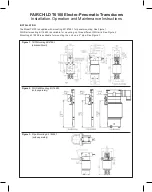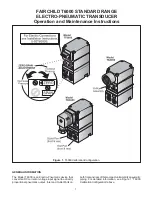
DP 6000 DIGITAL PAGING SYSTEM INSTALLATION INSTRUCTION 94
May 1999. Page 16
8.2.1 Location transmitter addresses starting with F.
Independent of the programming of the mobile this location will be transmitted directly to the central.
Furthermore, depending on the value of the second address digit of the location transmitter the mobile can give an
audible indication to the user as follows:
Location address starts with FF.
The mobile will emit a bleep signal until it is placed in a storage rack and the location is sent directly to the central.
NOTE: During the bleep signal the no move sensor is NOT ACTIVE.
Location address starts with FE.
The mobile will emit a bleep signal until it is reset by a short press on the Alarm/Reset button and the location is sent
directly to the central.
NOTE: During the bleep signal the no move sensor is NOT ACTIVE.
Location address starts with FD.
The mobile will give an attention bleep to the user (One short bleep signal) and the location is sent directly to the
central.
Location address starts with F0 to FC.
The mobile will transmit the location directly to the central without drawing the attention of the mobile user.
NOTE: Once the audible indication has been reset after passing a relevant location transmitter, this signal will not
be initiated again for as long as this location address is still in the memory of the mobile. Therefore it is advisable to
place a location transmitter with a different address in the area of the storage racks to refresh the location memory
of the mobile before it is stored in its rack.
8.2.2 Direct transmission of location dependant on first location address digit.
If the location address does not begin with F the mobile can be programmed (opcode 1U) to transmit a certain loca-
tion directly if the location address starts with the digit that is programmed here. In this way the installer can deter-
mine that certain locations are only transmitted directly by certain mobiles (e.g. for guard tour applications).
The mobile will transmit the location directly to the central without alerting the mobile user.
8.3
Storage racks
Try to prevent placing more than one mobile in or out of the storage rack simultaneously, this may lead to collision of
the in/out rack call.
Preferably, use storage racks that are connected to the central via the paging line. When a mobile is placed in a rack
it will transmit an in-rack call to the central which will be acknowledged by the central via the DP6000 line. In this
case the mobile will detect this response call via its rack contacts and it will stop sending calls until it is taken out of
the rack again, or until it is called again by the central via the paging line (which is detected again via the rack con-
tacts of the mobile).
This will limit the number of calls in the system and reduce the chance of collisions in the system.
8.4
Systems with speech
In systems where talk back speech is used, it is preferred to have the talk back on a different frequency channel and
on separate talk-back lines.


































